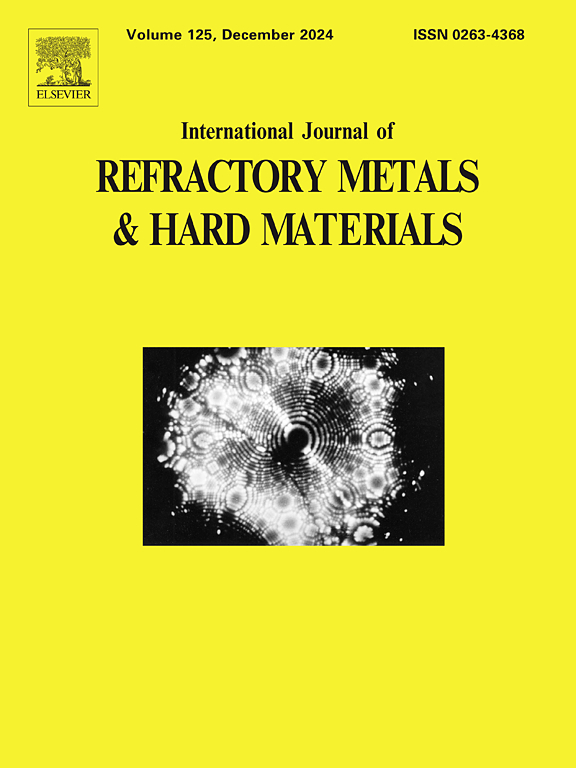Preparation of ultrafine WC-V8C7-Cr3C2-co cemented carbides by spark plasma sintering in-situ synthesis of composite grain growth inhibitors
IF 4.2
2区 材料科学
Q2 MATERIALS SCIENCE, MULTIDISCIPLINARY
International Journal of Refractory Metals & Hard Materials
Pub Date : 2024-10-02
DOI:10.1016/j.ijrmhm.2024.106910
引用次数: 0
Abstract
The growing high-precision manufacturing industry is increasing the demand for cemented carbide which has fine grain size and excellent machinability. In this research, ultrafine cemented carbide was successfully prepared by the method of in-situ synthesis using spark plasma sintering as densification method, V, Cr, WC and carbon black as raw materials. The formation mechanism of in-situ preparation of grain growth inhibitors (GGIs) and its influence on the properties of alloys were investigated. An excellent mechanical property (HV 2254 kgf/mm2, KIC 9.20 MPa·m1/2) and uniform microstructure of the alloys (0.8 wt% V8C7–0.8 wt% Cr3C2) prepared under 1350 °C, 6 min, 25 MPa were demonstrated by the results. The WC grain growth was significantly inhibited (about 200 nm). The in-situ synthesized GGIs significantly inhibited grain coarsening by interfering with the dissolution-precipitation process of WC during liquid-phase sintering. The combination of SPS and in-situ synthesized GGIs offers a novel approach to exploration of the preparation of high-performance ultrafine or nanocrystalline cemented carbides.
利用火花等离子烧结法制备超细 WC-V8C7-Cr3C2-co 硬质合金,原位合成复合晶粒生长抑制剂
随着高精密制造业的不断发展,对晶粒细小、切削性能优异的硬质合金的需求日益增加。本研究以火花等离子烧结为致密化方法,以 V、Cr、WC 和炭黑为原料,采用原位合成法成功制备了超细硬质合金。研究了原位制备晶粒生长抑制剂(GGIs)的形成机理及其对合金性能的影响。结果表明,在 1350 °C, 6 min, 25 MPa 下制备的合金(0.8 wt% V8C7-0.8 wt% Cr3C2)具有优异的机械性能(HV 2254 kgf/mm2, KIC 9.20 MPa-m1/2)和均匀的微观结构。WC 晶粒生长受到明显抑制(约 200 nm)。原位合成的 GGIs 在液相烧结过程中干扰了 WC 的溶解沉淀过程,从而显著抑制了晶粒粗化。SPS 与原位合成 GGIs 的结合为探索制备高性能超细或纳米晶硬质合金提供了一种新方法。
本文章由计算机程序翻译,如有差异,请以英文原文为准。
求助全文
约1分钟内获得全文
求助全文
来源期刊
CiteScore
7.00
自引率
13.90%
发文量
236
审稿时长
35 days
期刊介绍:
The International Journal of Refractory Metals and Hard Materials (IJRMHM) publishes original research articles concerned with all aspects of refractory metals and hard materials. Refractory metals are defined as metals with melting points higher than 1800 °C. These are tungsten, molybdenum, chromium, tantalum, niobium, hafnium, and rhenium, as well as many compounds and alloys based thereupon. Hard materials that are included in the scope of this journal are defined as materials with hardness values higher than 1000 kg/mm2, primarily intended for applications as manufacturing tools or wear resistant components in mechanical systems. Thus they encompass carbides, nitrides and borides of metals, and related compounds. A special focus of this journal is put on the family of hardmetals, which is also known as cemented tungsten carbide, and cermets which are based on titanium carbide and carbonitrides with or without a metal binder. Ceramics and superhard materials including diamond and cubic boron nitride may also be accepted provided the subject material is presented as hard materials as defined above.

 求助内容:
求助内容: 应助结果提醒方式:
应助结果提醒方式:


